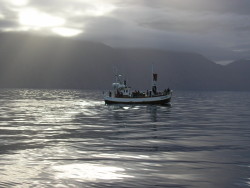 Photo.
Photo. Husevik
whale watching boat. © Joe Gill.
We had arrived two days before on a 40
minute flight from Reykyavik to this fjord town 60 miles from the Arctic. Whale
watching, pony riding and spectacular landscape were promised, and delivered.
But the late-night drinking was proving more elusive.
Going to the favourite karaoke pub in Akureyri, north
Iceland, at 9pm on a Saturday night when most UK towns are already heaving, we
found the pub shut and empty,
lights on eerily. The next bar that was open was more than quiet,
with 70s Elton John and Hotel California playing, designed to put you in the
mood to go home and sleep.
Akureyri's bohemian cafe, Carolina, did not feel very alternative, but we
waited in hope. Beer is famously expensive here, and drinking out was banned
until 1989, although the local brews served actually taste of something, which
is more can be said of the all-pervasive wife-beater brews back home.
The young Akuyrerians at Carolina were heading to the upstairs bar. We
followed. Plonking our selves in a corner we got to talking about history,
economics and the role of great men and the masses in history, the usual banter
for drunken historians and political scientists. I was the writer here to get
inspiration, he the political scientist enjoying a holiday after an academic
conference in Reykjavik. Eventually things livened up.
|
Photo. The author, Joe Gill from England, by
Lake Myvatn.
© Joe
Gill. |
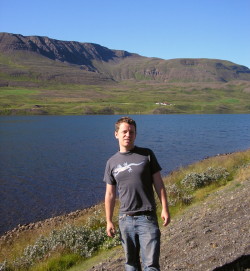 |
A fashionable young fella with laptop- a standard item in bars and cafes in
Iceland - proclaimed himself an artist from the Canary Islands, and made friends
with us. He had survived 2 winters here, which he explained required great
psychological strength and inner reserves. He made ends meet by killing sheep at
the local abattoir during the winter, then working in cafes and teaching art in
the summer. He had made plenty of money, he assured us, while seeing life from
another perspective, and delivering death to the sheep, all for his art. He said
winter was the best time to be in Iceland, and the big white-haired man he drank
with, with a wind tan and an infectious laugh, agreed heartily.
Before we could say 'odd couple', two more pints
appeared in front of us courtesy of the laughing Icelander. Proceedings were
under way. We were soon joined by some good-looking youngsters, a man and two
girls. They were friendly and tried out there English on us. A blonde and
brunette, may be our luck was in. They turned out to be 15 and 16.
Then Mullah Omar turned up, 6' 4", brooding, woolly hat, thick beard and
eyebrows, Afghan style long coat. He did not say much, staring at my friend and
strangely not drinking beer. We were assured that he was 100% Icelandic and was
only dressed like that for the look.
As for the ghostly appearance of the rest of town, we
were looked on kindly for our naivety. No self-respecting Icelander leaves the
house much before midnight. They stay at home until then, before starting a long night of
drinking till the early sunrise sends them home.
|
Photo. Gullfoss waterfalls in the south of
Iceland.
© Joe Gill.
This golden waterfalls come from
the mighty glacial river Hvita (White river). The cascade drops 32
metres into a narrow canyon which is 70 metres deep
and 2.5 kilometres long. |
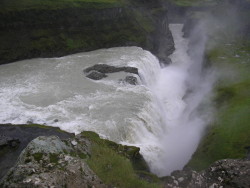 |
An Icelandic journalist, out with her husband, drunkenly tells me the English
are too polite, and asks if I share the affection of the artist, who has been
paying me a lot of attention, or whether my friend is my boyfriend and I say no,
I am straight. The artist says he is going home, but changes his mind. He
exhausts us with his life story of escaping a conservative Catholic village and
fleeing to the arctic.
The journalist says Hugh Hefner came here a few years ago and insulted
Icelandic womanhood in his search for the blonde, busty archetypes for his
empire, by calling Icelandic women the "Thais of the north". The town of
Akuyreri was once famous for having the highest density of strip bars in Europe,
much frequented by fishermen, until the local authorities brought in a
prohibition on touching and private dancing, which took all the fun away. Now
the fishermen have to go elsewhere for their kicks. And leaving us with nowhere
to go later.
|
Photo. The Blue Lagoon.
© Joe Gill.
Swimming here is wonderful. The temperature in average is about 40C
(104F), and the soothing, mineral-rich water is believed to have curative
powers. |
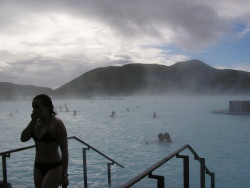 |
I discuss the behaviour of Icelandic and English women with the journalist,
now tipsy. She had seen an English woman in flagrant in the kids' swimming pool
in Spain, and assures me an Icelandic woman would never do that abroad. At home,
in contrast to the English, the Icelandic girl will do things on a night out she
would never do on holiday. I agreed, politely of course. She then invites us to
go whale watching the following day.
High latitude cruise ships still often stop at the Akureyri fjord. The local
airstrip is served by several propeller planes a day, diving in along the steep
glacier valley to the landing strip which has been built out into the water.
|
Photo. Myvatn
volcano.
The shadow in the foreground is me taking a picture of my friend
climbing up from inside the volcano.
© Joe Gill.
|
 |
If you ever wondered where they shoot those implausible car ads, the ones
with the chisel-jawed man driving serenely through mountain scenery on empty
roads with only the occasional puddle or mountain sheep to impede his journey,
the answer is Iceland. The trip by hired car from Akureyri to Lake Myvatn
(translation Midge Lake, and there were midges) left us speechless and blessed
out in amazement at the vistas of nature in all directions.
|
Photo. Joe Gill, the author, is looking into
a cave in Lake Myvatn. © Joe Gill.
|
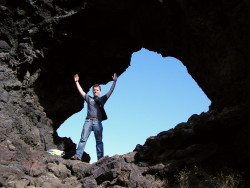 |
Iceland is the size of Ireland with a tenth of the population, and most of it
is uninhabited which, for a Londoner from one of the world's most crowded
islands, is enough to make you feel like a prisoner on day release. The
country's population could fit into a south London suburb.
Northern Iceland substituted for the Moon for the early NASA spacemen, who
climbed the craters that, being no older than the Bible, are as moon-like as you
could expect. I ran up and down one, kicking moon dust and rocks. There are
strange volcanic landscapes that would happily substitute for the polystyrene
Star Trek sets of old. Sulphurous lagoons, fluorescent blue and heated by
geothermic faults, transport you to the spa of the gods, or superman's back
yard.
On a clear day out on the plateaux you can see hundreds of miles of
wilderness, fast rocky rivers snaking through green plateaux, great waterfalls
and geysers. When it rains and the wind blows, which it does readily in August,
you take your life in your hands and can barely get out of the car in an exposed
stop. If New Zealand did for Middle Earth for Peter Jackson, I think Tolkien
must have been thinking of Iceland with its sagas, giants and skulking mountain
ranges. The old folk still believe in elves here, who will kill your sheep if
you cross them.
Iceland is made from the collision of two continental plates, creating a high
plateaux which was then sculpted by the ice. So much of its geology is only 2000
to 12000 years old; it's like being transported back to primordial times. Only
roads and the occasional lonely farm house spoil its rugged nature.
Back to civilisation, Reykjavik has a density of cafes and bars per square
inch probably as high as Amsterdam. Each is distinct and intimate. Sirius gives
you rock cool, big guys with Viking beards sipping pints, girls with sharp bobs
and thick-rimmed specs getting animated, to a blues rock sound track. At another
more subdued cafe, laptops are the favoured accessory.
Refill coffee is the great mercy in a land whose prices make you feel giddy
even coming from London. Every day out is like being mugged with a smile.
I didn't mention food, perhaps because it's expensive and mediocre. Pizzas
and burgers are the staple and a fish main course costs £30. I had a great
lobster soup on the remote island of Hirsa watching the rain outside, the
culinary highlight. A local delicacy is puffin, best smoked. Strange on an
island made wealthy by fishing, they don't eat seafood, perhaps something to do
with being a US base since world war two.
I go home to London knowing that I will cherish my £3 pint and marvel at
our low cab fares. Car hire is £50 to £80 a day in Iceland but compared to local
bus fares - try £20 for a 30 mile drive from Akureyri to the whale-watching
resort of Husavik - that makes car-hire the best way to travel. Unless you do it
like the intrepid Polish students we picked up en route, hitch hiking and tent
pitching across the whole island to save money. As the saying goes, life is
cheap but Iceland is expensive.
Joe Gill, 12 September 2005
Presentation of the author:
|
Joe Gill is a freelance journalist working
in London, specialising in the non-profit sector, international development and Latin America.
Photo. Joe Gill from England.
© Joe Gill.
|
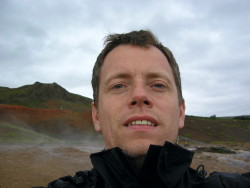 |
Contact details: Joe Gill, journalist, London 44 207 607 4120.
(M)
07748597168
(H) 0207 6074120
E-mail:
joegill00@hotmail.com
Little known facts:
1. England invaded Iceland in 1940, ending
Danish rule of 600 years.
2. Poles are now the biggest immigrant group
on the island.
